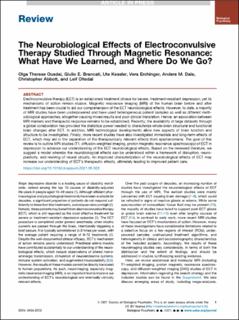| dc.description.abstract | Electroconvulsive therapy (ECT) is an established treatment choice for severe, treatment-resistant depression, yet its mechanisms of action remain elusive. Magnetic resonance imaging (MRI) of the human brain before and after treatment has been crucial to aid our comprehension of the ECT neurobiological effects. However, to date, a majority of MRI studies have been underpowered and have used heterogeneous patient samples as well as different methodological approaches, altogether causing mixed results and poor clinical translation. Hence, an association between MRI markers and therapeutic response remains to be established. Recently, the availability of large datasets through a global collaboration has provided the statistical power needed to characterize whole-brain structural and functional brain changes after ECT. In addition, MRI technological developments allow new aspects of brain function and structure to be investigated. Finally, more recent studies have also investigated immediate and long-term effects of ECT, which may aid in the separation of the therapeutically relevant effects from epiphenomena. The goal of this review is to outline MRI studies (T1, diffusion-weighted imaging, proton magnetic resonance spectroscopy) of ECT in depression to advance our understanding of the ECT neurobiological effects. Based on the reviewed literature, we suggest a model whereby the neurobiological effects can be understood within a framework of disruption, neuroplasticity, and rewiring of neural circuits. An improved characterization of the neurobiological effects of ECT may increase our understanding of ECT’s therapeutic effects, ultimately leading to improved patient care. | en_US |

